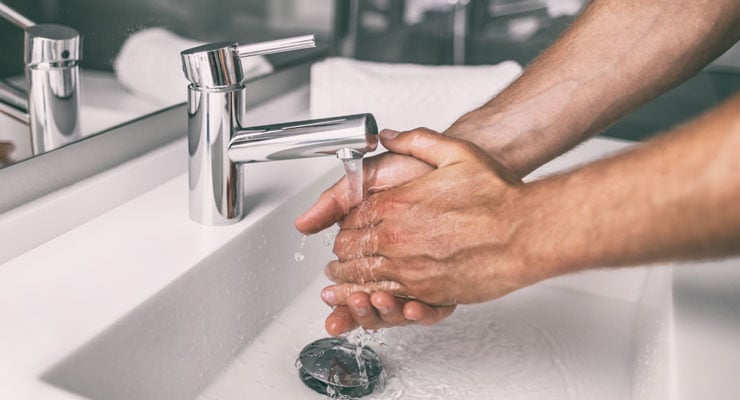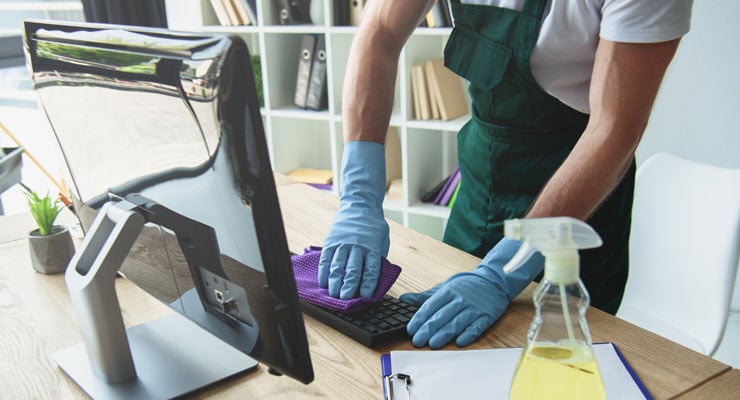 Written by: Emily Young // Mar 9, 2020
Written by: Emily Young // Mar 9, 2020
Last updated: Jan 17, 2023
Your co-worker is coughing. Unidentified slime lurks on the office sink. One of your valued business partners spits when he talks, and you’re doing Good Will Hunting calculations to decide how far away you should stand. You have, unfortunately, just watched Contagion.
Germ-fighters, unite! The office is never fun during cold and flu season, but we have weapons in our war against disease. Whether you’re an office manager or an employee armed with rubbing alcohol, you can defeat viruses with some easy tactics. (Our article is primarily focused on cold and flu season, but you can apply the following strategies to fight COVID-19, too.) Get ready for these simple tips to sustain workplace health.

Encourage Hand-washing
Killing germs isn’t glamorous. It does not involve fun accoutrements like stakes or silver crosses or garlic necklaces. Your weapons? Soap and water. Your reward? Saving lives.
Here are just a few reasons you should scrub up:
- Hand-washing “reduces respiratory illnesses, like colds, in the general population” by 16 percent to 21 percent, according to the Centers for Disease Control and Prevention (CDC).
- It can stop the spread of dangerous diseases: “During the SARS epidemic, hand-washing reduced the risk of transmission by 30 to 50 percent,” according to The New York Times.
- If everyone washed their hands regularly, it could save a million lives every year.
Encourage everyone in your office to frequently wash their hands, especially in the following circumstances:
- After using the bathroom. (Apparently, nearly 70 percent of men and 35 percent of women skip this step.)
- Before preparing or eating food
- After touching garbage
- After blowing their nose, coughing, or sneezing
The way we wash our hands is also important – but if you believe this study, only about 5 percent of us do it right. Follow these guidelines:
- Wet your hands with water.
- Lather your hands for about 30 seconds using soap. (If you want to feel festive while you’re sudsing, sing the happy birthday song twice. That will give you about the right amount of disinfecting time and remind you of delicious birthday cake. Win-win.)
- Make sure you lather everything, including those easy-to-miss places like “the backs of your hands, between your fingers, and under your nails,” says the CDC.
- Use a clean towel to dry your hands. (Don’t trust that office towel? We don’t blame you. Air drying is also OK.)
Communicate proper hand-washing to your colleagues:
- Print out these hand-washing signs from the CDC. Place them in common areas such as the bathroom and kitchen.
- If you are a manager, invest in training and education on the topic of clean hands. Studies have shown that promoting hand-washing reduces employee sick time.
- Don’t limit instruction to cold and flu season. Advocate for hand-washing throughout the year with the CDC’s campaign toolkit.
Provide Hand Sanitizer
Think of everything you touch in the office, from shared keyboards to the hand of a sniffling business partner. (You may also want to consider alternatives to the classic handshake: Bump elbows, wave, or bow.) Hand sanitizer – easy to transport, discreet to dispense – has your back.
True, sanitizer isn’t as effective as soap and water, but it’s better than nothing. Look for an alcohol-based hand sanitizer with at least 60 percent alcohol, and follow the CDC guidelines: “Apply the product to the palm of one hand (read the label to learn the correct amount) and rub the product all over the surfaces of your hands until your hands are dry.” Make sure you wait till it dries – about 20 seconds – if you want it to work.
If you are in leadership, consider implementing a hand sanitation program. For example, one company “installed hand-sanitizing stations in high-traffic common areas, conference rooms and break rooms, and gave hand sanitizer bottles and hand sanitizing wipes to each individual,” according to this U.S. News & World Report article. Just look at the results for offices with such programs:
- A 24 percent reduction in health care claims for diseases such as colds and flu
- More than a 13 percent reduction in “unscheduled paid time off”
- Eighty percent of employees “indicated that having access to hand sanitizer positively impacted their impression of their employer.”
Don’t Touch Your Face
If you’re like most people, you touch your face 23 times every hour, according to a study cited in this Washington Post article. But if you learn how to stop, it’s “the one behavior that would be better than any vaccine ever created,” says an expert quoted in the article.
How do you stop?
- Write “Don’t Touch Face” on a Post-it note and put it within eyesight. (Yes, your co-workers will have questions. But they might just learn something.)
- Practice mindfulness to reduce anxiety (which is one reason we touch our faces).
- Use a stress ball to give your hands something to do.

Cough Like Dracula
There’s a right way to cover your cough or sneeze – and there’s a wrong way.
- Don’t simply use your hand. (Think of everything you might touch after you sneeze into your palm.)
- Instead, if you have to cough or sneeze, cover your mouth and nose with a tissue; then throw away the tissue in a garbage can. Disinfect your hands.
- No tissue handy? Cough or sneeze into your elbow. (This method has been called the Dracula cough because it looks like a vampire hiding in its cape.)
How do you get colleagues to comply?
- Again, education is key. Post signs and host trainings.
- Make sure tissues and garbage cans are easily accessible for all employees. You can also provide face masks.
Disinfect Surfaces
Prepare yourself. You are going to read some very gross facts about beloved office objects:
- Would you rest your cheek against a toilet seat? Your phone boasts 10 times more bacteria, according to a study quoted in Time. The same article suggests that you clean your phone with a microfiber cloth dipped in a mixture of 60 percent water and 40 percent rubbing alcohol. (If that mixture sounds too complicated, you can use individual alcohol wipes. Disinfect your phone once a day, especially during cold and flu season.)
- The desk you’re leaning on right now has 400 times more bacteria than a toilet seat.
- If your desk is that gross, just think what your keyboard contains. Luckily, you can clean it with some rubbing alcohol and a microfiber cloth. (Read this New York Times article for more detailed instructions.)
- That office mug you hope your co-worker washed? Please don’t spit out your coffee all over your newly cleaned keyboard, but the mug may have fecal matter on it. (Time to bring a thermos from home.)
- Before you rush to the kitchen to wash your office mug, examine that sponge. The average kitchen sponge is home to “more than 20 million colonies per square inch.” Just think of the bacteria your office sponge hosts. Experts recommend you buy a new sponge each week.
- After reading these facts, you may want to grab your briefcase and bolt for your nice, clean home. Pause before punching the first-floor elevator button. It has more than 600 bacteria per square inch.
You get the idea: Make sure you are frequently disinfecting common areas (including door handles). You can also distribute disinfectant wipes to employees so they can take matters into their own hands, especially after reading this post.

Stay Home When Sick.
If you’re sick, stay home. This reduces the chance you’ll infect others.
Of course, this requires approval from your supervisors. Managers, it’s crucial you take these steps:
- Offer paid sick leave, and encourage employees to take it.
- Provide flexible work-from-home policies, and make it clear that if an employee is unwell, they should work from their couch.
If you do this, you will literally be saving lives. “Flu rates would fall 5 percent if paid sick leave were universal,” explains this New York Times article. “According to one estimate, an additional seven million people contracted the H1N1 flu virus in 2009 because employees came to work while infected. The illnesses led to 1,500 additional deaths.”
Have a Preparedness Plan for Emergencies
What happens if your business faces a possible pandemic, such as COVID-19? Review these preparedness guides designed for organizations:
For example, one way you can reduce the transfer of disease is to limit the number of employees gathered together. (The CDC suggests you can replace “in-person meetings with video or telephone conferences and increase teleworking options.”)
Although planning for these scenarios is scary, it’s better to be prepared. If you’re a supervisor, communicate to your team how the company is prioritizing worker health and safety.
We’re Here to Help
Do you want a cheat sheet of these tips? Are you hoping you can email it to your co-workers and get Hand Cougher Bob to stop his bad habits? Do you plan to distribute it discreetly near the bathroom? Are you recruiting colleagues for a heist to hide the office sponge? We’ve got your back.
At USF’s Office of Corporate Training and Development, our goal is to build a world-class workforce in the Tampa Bay area. We hope our tips have helped you maintain a healthier office environment, and we’re here to support you in any way we can. Explore our professional development programs, or contact us at 813-974-0950. Stay well!


